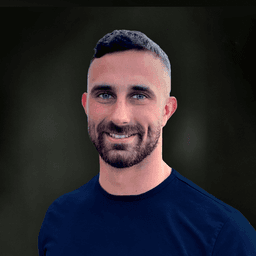How Ben Zogby Made $1.8 Million By Transforming HighStrike Trading From Unsellable To Irresistible


Business Description
Table of Contents
Navigate through the case study sections
Executive Summary
Case Study Content
Turning an Unsellable Trading Business Into a $1.8M Exit: Ben Zogby & HighStrike Trading
Ben Zogby’s story is a punch-in-the-gut reminder that even a thriving business can be unsellable, at least, for a while. In 2020, HighStrike Trading, his online trading education startup, was turning decent profits. Yet when Ben went to sell it, buyers weren’t interested at all. The feedback was clear: the business relied too heavily on its founder.
HighStrike grew out of Ben’s personal need. As a college student in Boston around 2016, Ben struggled to trade stocks profitably. He spent hundreds of hours in forums, books, and chart patterns. By 2018, now an engineering grad, his trades turned the corner, and he’d saved $150,000 from both his job and his growing trading success.
From Side Hustle to Full-Time Focus
Overdosed on spreadsheets and cubicle life, Ben quit engineering and put everything into HighStrike Trading. He was betting not just on a market, but on providing guidance to the many people who, after the 2019 bull market and especially into the pandemic, wanted actionable trading advice they could trust.
At first, every course, marketing email, and Instagram DM came straight from Ben. It paid off: the COVID-fueled spike in at-home traders brought a wave of new customers. His Instagram account exploded, as did recurring business, thanks to timely, organic content tailor-made for people hungry to learn options and day trading. But the growth masked a problem: every single lesson, livestream, and customer support thread needed Ben. That’s risky. Buyers want a business, not a personal brand bottleneck.
Failed Sale: A Brutal Wake Up Call
When Ben listed HighStrike for sale in 2020, he got crickets. Not a single real bite. The verdict? The business might as well have been a solopreneur job. Instead of writing off the dream, Ben dug in: he picked apart what buyers actually care about, recurring revenue, clean documentation, skilled staff, and a system that would hum whether Ben was there or not.
He switched from one-time course sales to a recurring subscription model. He tracked every metric and KPI, no more gut-feel. Ben worked hard, sometimes too hard, on hiring. It took him months to find content managers, professional traders for other strategies, sales experts, and even a CEO/COO to lead the operation after he’d gone. Instead of "Ben, the stock wizard, " buyers were getting a brand supported by a team, process docs, and growth systems.
Building A Brand (Not Just A Personality)
Ben believes this shift, from focusing on maximum sales or marketing persona, to building a stable brand with staying power, is what finally made HighStrike sellable. Systemization became the mantra: detailed SOPs, DEI in hiring, leadership transitions, documented reporting, all that. By the time HighStrike relisted on Flippa in late 2022, the business practically ran itself. His team: three full-time trading experts plus four support and management staff, running content, sales, customer support, and the CEO layer. Students now got access to multiple proven strategies and coaches, not just a single red-hot trader.
The HighStrike Exit: Bidding War to Sold
In October 2022, Ben listed on Flippa. This time? Interest poured in. Not just one offer, multiple buyers lined up, and a bidding war pushed the price from $1.5M (the valuation) to $1.8M. The due diligence phase dragged on for months as it always does with 7-figure deals, but the new structure worked: everything was in order, dependencies low, subscription income steady, documentation clear, and an operator ready to step in.
On August 1, 2023, Ben closed the deal and stepped away with $1,800,000, not counting whatever he made running the business along the way. He credits Flippa’s team for stoking demand and guiding the process, but as any founder knows, no one can make up for bad prep. Ben did the ugly, tiring, slow work of building a company where he wasn’t irreplaceable, and it changed everything.
After The Sale: Teaching Others How To Exit Right
Instead of sitting on the windfall, Ben started ExitFrog, a business aiming to help other founders structure their startups for seamless, high-value exits. He argues that every online business, even if you think you’ll never sell, ought to become "exit ready." That means investing a few months in building systems, enforcing clear KPIs, and baking in recurring revenue, so you’re always prepared for surprises and lucrative buyouts. Ben’s approach isn’t just for online education or trading; systemization, smart hiring, and documented operations are the hallmarks of any business you’d actually want to buy.
Hard Lessons (& Wins) Along The Way
- Hiring right took Ben much longer than he expected, sometimes three months to find one key player, but it meant he could step away and the business didn’t miss a beat.
- Moving to a subscription model didn’t just pad valuations; it stabilized cash flow and increased retention for HighStrike’s offers.
- Social media, especially Instagram, generated the initial interest and energy. But ultimately, word of mouth, expert teams, and student success drove long-term growth.
- Documentation, everything from how email campaigns run to how performance gets measured, became one of Ben’s best selling points to buyers.
- Ben calls the process life-changing. He claims it set him up for all future business, both skill-wise and mindset-wise. His number one tip: build to sell, even if you never do.
Takeaways For Founders Who Want To Sell For Millions
- Don’t just focus on profits, focus on how you’ll replace yourself. Productize your offers, build a skilled team, document every workflow, and bake in recurring value.
- Slice up founder dependence. What can only you do, and what can a pro you hire take off your plate?
- Start tracking your business like an outsider: clean P&Ls, marketing analytics, and systematized reporting build trust and speed up due diligence.
- Take feedback, even painful "no thanks" from buyers, and treat it as blueprint for what to fix.
Ben Zogby’s HighStrike Trading shows that the road to a life-changing multi-million-dollar sale isn’t always about the flashiest marketing or quickest growth. Structure, team, and process beat personal fame almost every time. If you’re hustling now, think about how you could hand your business off tomorrow. Could you? If not, you know where to start.
Business Plan
Market Problem
HighStrike Trading faced a critical issue where the business was overly reliant on its founder, Ben Zogby. Buyers in 2020 were not…
See the full market problemSolution
To address these challenges, Ben Zogby undertook a comprehensive overhaul of HighStrike Trading. He shifted from one-time course sales to a…
See the full solutionTarget Market
Beginner Traders
Individuals new to trading who seek foundational knowledge and guidance to start investing successfully.
Intermediate Traders
Those with some experience who want to enhance their trading skills and learn advanced strategies for better returns.
Competitors
Investopedia Academy
Offers a range of online courses aimed at teaching stock trading and investment strategies.
Warrior Trading
Focuses on day trading education with an emphasis on live trading sessions and community support.
Competitive Advantage
HighStrike Trading's primary competitive advantage lies in its transition to a team-based operation with a subscription model. This shift…
See the full competitive advantageSales and Marketing
HighStrike Trading has effectively utilized Instagram as a primary channel for marketing, focusing on organic content that resonates with…
See the full Sales and marketing planSuccess Milestones
Initial Market Research
Conduct thorough research to identify target audience needs and preferences in trading education.
Transition to Subscription Model
Implement a recurring revenue model, shifting from one-time course sales to subscriptions.
Key Takeaways
- 1Attempting to sell HighStrike Trading in 2020 failed because the business relied entirely on Ben, showing the importance of minimizing founder dependence.
- 2A shift to recurring revenue and systematized operations made HighStrike much more attractive to buyers and significantly boosted its valuation.
- 3Hiring top-quality employees, even if slow, enabled Ben to delegate key tasks and build a business that could run independently.
- 4Documenting every key workflow with SOPs and detailed metrics was crucial for buyer trust and a smooth acquisition process.
- 5The $1.8M exit was $300,000 above the initial asking price after a bidding war, proving the value of exit-readiness and competitive offer environments.
- 6Ben parlayed these lessons into a new venture, ExitFrog, to help other founders structure their companies for stress-free and lucrative exits.
Key Facts
Tools & Technologies Used
Premium Content Locked
Subscribe to access the tools and technologies used in this case study.
Unlock NowHow to Replicate This Success
Premium Content Locked
Subscribe to access the step-by-step replication guide for this case study.
Unlock NowInterested in Being Featured?
Share your success story with our community of entrepreneurs.
Explore More Case Studies
Discover other inspiring business success stories

How Marksson Sold a Profitable Amazon FBA Wall Clock Brand in Just 7 Days
Mark Segal leveraged his 15 years in startups and ecommerce expertise to build and systematize Marksson, a profitable Am...
Marksson

How Jason’s ConvertCase Tool Turned an Hour’s Work into $20K/Month
ConvertCase began as a quick hack to silence all-caps emails and evolved into a full suite of text, image, and data conv...
ConvertCase
How a Telegram Bot Strategy Net $1,000+/Mo
After months of dead ends in crypto raffles and push ads, one affiliate marketer found a hidden goldmine in Telegram's s...
Telegram Affiliate Venture
